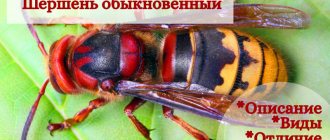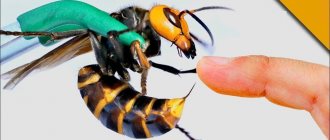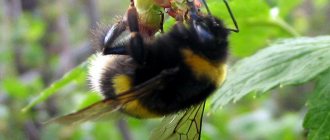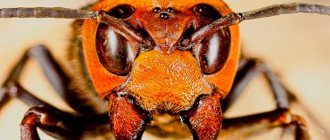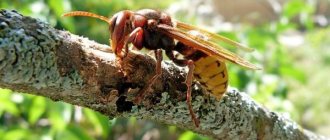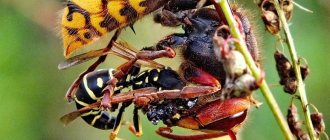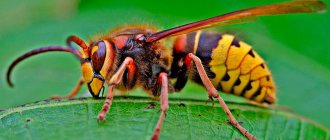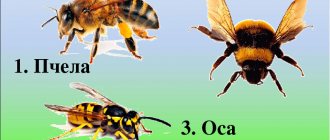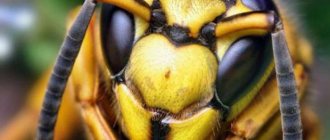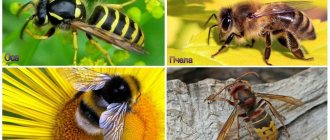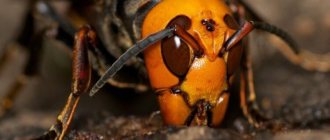- Where do hornets live?
We are surrounded by many amazing living creatures and one of them is the hornet. Our today's hero is not very loved by people, of course, because hornets are capable of attacking a person and stinging him painfully. Hornet venom can cause an allergic reaction, and in large doses (that is, with multiple stings) can even be fatal. But on the other hand, hornets are also very useful insects, including, they are simply magnificent
architects and builders, it all depends on the eyes with which we look at them. Our article today is about them.
Description, structure, characteristics
The hornet belongs to a type of arthropod insects and a subclass of winged insects, its Latin name “Vespa” can be translated as “wasp”, in fact, the hornet is the largest wasp.
The size of the hornet averages from 1.8 to 3.5 cm and the largest of them are representatives of the species Vespa mandarinia, reaching 5.5 cm in length.
Vespa mandarinia is the largest hornet in the world.
You are probably wondering what is the difference between a hornet and a wasp. Let us answer that the hornet differs from an ordinary representative of the wasp family in the larger size of its head, which has a wide crown, while part of the hornet’s head is located behind the compound eyes. In addition to them, the hornet also has 3 ordinary eyes. The color of the head can be orange, yellow, reddish-brown, even black, interspersed with yellow spots. There are antennae on the head, and what is interesting is that their number is different in females and males, and this characteristic structural feature of hornets is one of the elements of sexual difference.
The hornet's abdomen is round in shape, and also has a slender waist in the area of the articulation with the chest. In general, the colors of hornets are very similar to the colors of wasps, the difference is that the alternation of black and yellow stripes in hornets is not so bright.
Females and queens have an ovipositor at the tip of the abdomen, which at the same time is the famous sting. In its normal state it will not be possible to notice it, since the sting is retracted into the abdomen. The sting itself is straight and smooth, without serrations (like
bees) and for this reason, hornets can use it repeatedly, just like other wasps, whose sting design is very similar. There is also a special poisonous gland at the base of the sting, which makes the hornet’s bite very dangerous to humans.
The hornet also has three pairs of legs, yellow, brown or black (depending on its type). The structure of the limbs is not very simple; they consist of a coxa, trochanter, femur, tibia with a spur and the tarsus itself.
Hornets are excellent flyers, thanks to their wings, which, like many other flying insects, have as many as 4: two front and two rear. During flight, the small rear wings are attached using special hooks to the large front wings, resulting in a single flying surface.
Natural enemies of hornets
Photo: Hornet insect
Hornets don't have many natural enemies. This is due to the fact that these insects are relatively peaceful. They prefer to run away from the enemy. Only by defending itself can a hornet show itself as a real hunter. Such animals are especially ferocious if someone has coveted their nest, offspring, or uterus. Also, the small number of natural enemies is explained by the toxicity of hornet wasps, as evidenced by their bright color. Other animals try to avoid such insects.
Some of the natural enemies of hornets include:
- small parasites. Nematodes, parasites, and mites slowly but surely kill large hornets and greatly undermine their health;
- some types of birds. Only certain species of birds are able to hunt representatives of social wasps. Most birds simply swallow them whole, preventing the insect from stinging them;
- fungi. The fungus can grow in the hornet's head, leading to a painful and long death;
- other insects. Hornets can be killed by larger wasps and ants. Ants most often feast on insect larvae;
- of people. Despite the benefits they bring, hornets are considered pests. They settle in residential buildings, are quite dangerous to human health and life, and cause significant damage to young trees. For this reason, hornet nests are often destroyed by people.
Nest
We have already mentioned earlier that hornets are excellent builders and architects and a clear indication of their skill will, of course, be the large, multi-tiered nests built by them.
Hornets build their nests in a variety of places: in tree hollows, birdhouses abandoned by birds, in caves and attics of human buildings, on steep cliffs and hanging over tree branches. The color of the nests, as well as the shape, come in a wide variety of variations: brown, yellow, yellow-white, beige, purple; in shape they can resemble a pear, an oval or a large ball. The size of the nest can reach up to 70 cm in height and up to 40 cm in width.
Interesting fact: the process of creating hornet nests is a little similar to the process of creating paper, which is why such nests are sometimes called paper nests. The fact is that the materials used for construction are soft wood fibers and tree bark, which the hornets carefully chew and glue together with their sticky saliva. They apply a thin layer of this viscous mass onto the nest, and after hardening it turns into some kind of paper - you can even write on it with a pencil, although, of course, the quality of such “paper” will be significantly inferior to ordinary paper.
It is interesting that among the representatives of the hardworking kingdom of hornets, there are also hornets - drones and robbers. Such, for example, is the Dybovsky hornet, which does not build its own nests, but instead likes to settle in the built nests of hornets of other species, killing the local queen, taking her place and laying its eggs on worker hornets that are in the dark. This is a real palace coup in the kingdom of hornets
But some eastern species of hornets have a tendency to build underground nests with an extensive system of passages and tunnels. In some ways, such nests resemble anthills or termite mounds.
Difference from wasp
Hornet and wasp.
Large dimensions and an enlarged nape distinguish this species. They also have a different color. The back, belly, and antennae of hornets are brown, while that of the wasp is black. Otherwise, they have an identical body structure, thin waist, sting, strong jaw.
The personalities of insects also differ. Large hornets are not as aggressive as wasps. They begin to attack when approaching their nest. The impressive size and menacing buzzing cause great fear in people.
Nutrition
In terms of their feeding style, hornets are omnivorous insects, but they are still mostly vegetarians, preferring plant foods, especially if they are rich in sugar. They especially love overripe fruits: apples, pears, plums, they adore honey and nectar, which is why they often raid bee apiaries. If necessary, the hornet can turn into an excellent hunter, whose prey will be flies, grasshoppers, dragonflies, spiders,
butterflies, bees and even their closest relatives, wasps. Some particularly warlike species of tropical hornets can destroy up to 500 colonies of bees and wasps within their lifetime (not at all long)!
Interesting fact: representatives of the Vespa bicolor tropical hornet species living on Hainan Island sometimes attack orchids, mistaking them for bees by their smell.
But what is curious is that the prey killed by the hornet, which is thoroughly chewed into a suspension, is not used as food for the hornets themselves, but serves as a source of food for feeding the voracious larvae during their growth period. Sometimes hornets find dead insects for this purpose, which they also chew as food for their offspring.
What does an insect eat?
Hornets feed on nectar and plant foods containing a lot of sugar. Insect preferences include ripe fruits, berries, flower nectar, honey and tree sap.
At the same time, hornets are predators. They hunt insects to feed their larvae. With the help of its sting and powerful jaws, the hornet easily copes with flies, horseflies, gadflies, bees, wasps, grasshoppers and locusts. It completely chews the prey and feeds it to the larvae.
Reproduction
Hornets are social insects with a complex hierarchical structure and caste system. Each hornet performs its strictly defined role, depending on its caste. The division into castes: female worker hornets, males and the queen, helps the hornet kingdom organize, including their proper reproduction, nutrition, nest building, protection of their colony and many other useful and important things.
With the onset of warm days, the queen flies around the territory in search of a suitable place to build a nest where a new colony of hornets will live. When a suitable location is found, the queen begins building honeycomb cells. Then one egg is placed in one cell, from which a small larva forms after a few days. In two weeks it will turn into a pupa, which, in turn, again after two weeks will become a fully grown individual, capable of gnawing through the lid of the cell and coming out.
The origin of the name “hornet”
Why is the hornet called that?
It is known that the roots of the word “hornet” come from the Latin phrase “vespa crabro”, which literally translates as hornet wasp. Common hornet
is a subspecies of a large wasp that lives throughout Europe. There are also Asian hornets, which are larger in size than ordinary ones.
People call hornets by different names: “flying corsairs”, “pirates” and so on.
In the 19th century, biologists divided one genus of hornets, Vespa, into two different genera - vespula, which includes only wasps, and vespa, which only includes hornets.
Types, photos and names
Here are the most popular and interesting, in our opinion, species of representatives of the hornet kingdom.
Common hornet
She is also a hornet wasp - a very large representative of the hornet family: the queen reaches a length of 2.5-3.5 cm, the males are somewhat smaller - 2.1-2.8 cm. Females and males also differ in structure: for example, males have antennae of 13 segments, in females from 12. It is interesting that only females have a sting (they use it mainly for protection), males are deprived of it. Their abdomen is colored with alternating stripes of orange-yellow and black. The common hornet lives in all European countries (including Ukraine), China, Kazakhstan, North America
Hornet is deplorable
This representative of the hornets is a full citizen of the Philippine Islands, which is where their habitat is. Unlike ordinary hornets, they are black in color. The mournful hornet is also one of the most dangerous, since this species produces a special highly toxic poison, which makes its bite especially unpleasant.
Eastern hornet
She is also an eastern wasp - another representative of the hornet family, as you guessed by the name, living mainly in the east: in Turkey, Iran, India, Pakistan, Oman, China, Nepal and some other countries. But representatives of this species are also found in southern Europe: Italy, Romania, Bulgaria, Greece. It is not without reason that he lives in these southern places; he especially loves warm and hot climates and tolerates them well. A characteristic feature of the eastern hornet is the presence on the abdomen of a wide stripe of a yellow-whitish hue. According to the observations of scientists, this very stripe contains a special pigment xenotropin, which allows insects to convert absorbed sunlight into electricity. Further research in this area could yield amazing results in the energy sector, but let's return to the hornets.
Dybovsky's Hornet
He is also a black hornet, already mentioned in our article, in connection with his predatory parasitic habits - this species rarely stands its own nests, preferring to seize others. They live in China, Thailand, Japan, India, Transbaikalia.
Giant Asian hornet
Or Vespa mandarinia has also already been mentioned in our article as the largest hornet in the world - the length of some representatives of this species exceeds 5 cm. It is also the proud owner of the longest sting (about 6 mm), which makes its bite very painful and dangerous. Lives in Asian countries: Korea, China, Nepal, India, mainly in mountainous areas.
Japanese hornet
It is actually a subspecies of the Asian giant hornet native to Japan, where it is also called the “sparrow bee.” It is also a very large representative, its body length often exceeds 4 cm. It is also very dangerous; due to the presence of nerve toxins in the venom, its bite can be fatal; in Japan, about 40 people die every year due to the bite of this insect.
Where does the hornet live?
Photo: Asian hornet
Representatives of this genus are widespread in the Northern Hemisphere. Their habitat depends entirely on the characteristics of the species. So, the most popular is the common hornet. This is the only species that lives in large numbers in Ukraine, Russia, and North America. In Russia, this wasp is represented more in the European part of the territory. You won't find it in the far north. The common hornet also lives in Japan, Korea, and China. Small populations of the animal can be found in Mongolia and Kazakhstan.
North America is not the natural habitat of the common hornet. The insect was brought there quite by accident back in the nineteenth century.
The Asian hornet lives in most of the territory of Asia, in the Jewish Autonomous Region, in the Primorsky and Khabarovsk Territories. It is large in size; in Japan this insect is called the “sparrow bee”. Also in tropical Asia, as in France and Spain, Asian predatory wasps are common. They build their “houses” on tree branches, feed and hunt bees.
The eastern hornet wasp chooses semi-dry subtropical areas for living. It can be found in Uzbekistan, Afghanistan, Turkey, Italy, Romania, Greece, North Africa, and other European and Asian regions. On the vast territory of the Russian Federation, scientists have noticed eight species of hornets. The common oriental hornet lives in the European part of the country. The other six species of insects live in the south of the Far East.
What to do if bitten by a hornet
If you have been bitten by a hornet, you must immediately take the following measures:
How dangerous are hornets to humans?
Hornets can pose a threat to humans in some cases. To ensure their safety, the hornets gather very quickly; for this, the individual secretes a special substance - an alarm signal. Other people may react to this by flying to the aid of their comrade and attacking the criminal en masse. Therefore, you should not touch the hornet in vain.
The mortality rate after a hornet sting is very low, but the risk still exists. In addition, each subsequent bite will be worse for the body, since resistance to the poison will not develop, but on the contrary, the negative reaction will intensify.
How to get rid of hornets
Hornets, despite the danger posed by them, also bring benefits, for example, they destroy various harmful insects, all kinds of garden and vegetable pests. But still, there is no place for them to live next door to a person. And the hornets themselves do not often appear near human dwellings; they are usually attracted here by sweet aromas: the smell of honey or overripe fruits.
If a hornet accidentally flew into your window, do not try to drive it out by furiously waving a rag or other object, it may well sting you. It’s better to wait until it calms down and sits down like some kind of surface and quickly cover it with a simple glass jar. Then carefully release the hornet outside.
Benefits and harms
Hornets are useful in that they destroy insects, making it easier for gardeners to combat garden pests, but the hornets' usefulness ends when they settle in apiaries.
Hornets - the storm of bees
In autumn, honey bees become the main food of hornets - other insects already die at this time.
When raiding hives, one hornet can eat about 30 bees in a day.
When uninvited guests appear, beekeepers try to get rid of them by all possible means.
Being too close to hornets can also be dangerous for humans. An insect bite causes burning pain and can provoke severe allergic reactions.
The bite can be dangerous to humans
Consequences
When attacking, a hornet can bite one or more times. A single bite is not as dangerous to humans as multiple bites. Getting large amounts of insect venom under your skin can cause serious problems.
After a hornet attack, a person experiences body intoxication , which leads to the following consequences:
- dizziness, headache, signs of nausea and vomiting.
- fever and chills, sweating.
- difficulty breathing, shortness of breath, in rare cases, convulsions.
The consequences may vary in severity. It depends on the type of hornet, on the person’s immune system, on his age and sensitivity to allergens. Children are the most susceptible to hornet venom. The most dangerous consequence of a hornet attack can be Quincke's edema and anaphylactic shock.
Help with a bite
There are several first aid rules for a hornet sting that will help minimize the consequences of an attack by the largest wasp. The sequence of actions is as follows:
- Examine the bite site and remove sting particles with tweezers, if any.
- Carefully squeeze out the insect venom.
- Wash the wound with soap and then wipe it with a solution of alcohol or potassium permanganate.
- Apply cold.
- Take an antihistamine.
You don’t need to visit a doctor if the hornet has bitten you only once and there is no deterioration in the victim’s condition. However, you should consult a doctor if the following signs are present:
- severe pain and extensive swelling of the bite site;
- weakness and severe manifestations of allergies;
- attack by several hornets at the same time;
- The victim's age is under 16 years.
Burrowing wasps are very caring parents. Paper wasps are named so because of the way they build their nests. A complete description of the insect can be found here.
A road wasp sting can be quite dangerous, especially if a person has allergies. What to do if you are bitten, read the article at this link.
How to Avoid a Bite
The hornet attacks only when it senses danger to itself or its nest. At the first threat, it releases a special substance - alarm pheromone , which serves as an attack signal for other individuals. Therefore, you should not kill the hornet near the nest. Hornets,
sensing the smell of danger, the whole family can attack the offender of their relative.
It is advisable to destroy hornet nests only in cases where they threaten bees or their nests are located too close to housing. If the insects have built their home where they will not be disturbed, there is no need to be afraid of their attack. On the contrary, they will even become assistants in protecting the crop from other insects.
Of course, the hornet can be dangerous to humans. However, you can coexist peacefully with it, if you take into account its habits and characteristics. It is also better not to come close to it and not disturb its nest. And it is important to remember that in nature there is nothing superfluous, which means it is better to protect hornets rather than destroy them.
Video
And finally, we bring to your attention a film about our heroes, under the menacing title “Hornets - an empire of ruthless killers.”
Author: Pavel Chaika, editor-in-chief of Poznavaika magazine
When writing the article, I tried to make it as interesting, useful and high-quality as possible. I would be grateful for any feedback and constructive criticism in the form of comments on the article. You can also write your wish/question/suggestion to my email [email protected] or Facebook, with respect, the author.
Author page
Harm from toxic hornet venom
The sting of a hornet is very painful for people.
It cannot be compared to a wasp or bee sting. It all depends on the individual characteristics of each person’s body. If you are stung by a hornet, you should immediately seek medical help or provide it to yourself. Insects have a needle with which they can pierce the skin not just once, like bees, but an unlimited number of times. It is also worth remembering that varieties of hornets living in Asia are more poisonous than hornets from Europe.
Usually after a bite there is severe pain and swelling in the affected area. Hemorrhage and subsequent suppuration of the wound are also possible.
Wintering
The organisms of these insects are poorly adapted to living in frosty conditions. Hornets carefully prepare their habitats for winter.
With the onset of the cold season, insects begin to eat abundantly and store nutrients to last throughout the winter. And also in the fall they search for a calm and safe place. There should not be large temperature changes in it. Wintering dwellings must be protected from birds, because birds actively hunt bushes.
Life expectancy and living habits
A clear hierarchy has been established in a hornet nest, according to which each adult occupies a certain position and performs only specified functions. This caste classification makes it possible to most effectively distribute responsibilities among all individuals, organizing the structure of the nest, feeding the growing voracious larvae, and protecting the nest from attack.
According to caste, all individuals in the nest are divided into three groups:
- The uterus (queen) is responsible for reproduction and breeding, and is also the most important individual in the nest. Its life cycle can reach 2 years, but usually lasts about 1 year;
- Males are intended to fertilize young females. After mating has taken place with female individuals who will become queens in the future, the life expectancy of males is no more than 2 weeks;
- Working individuals (females) make up the majority of the total number of insects in the colony. They are responsible for feeding the offspring, further building the nest and protecting it from pests. The lifespan of working females is about 30 days.
Important! Towards the end of its life cycle, the hornet's queen noticeably ages and becomes lethargic, and her wings take on a frayed appearance.
Where live?
The natural habitat of hornets is all regions of the planet with a temperate climate. The largest number of these insects is found in Europe, but various representatives of this family can also be found in North Africa, Asia and North America. To live, insects build large nests, which can consist of more than 10 tiers. They house the queen, males and female workers.
Consider the description of the appearance of the nest:
- The design consists of many tiers and can be round, oval or pear-shaped. At the bottom of the nest there is a round hole that serves as the entrance.
- The surface of the nest is rough and looks like corrugated paper.
- The color of the nest can be brown, yellow, beige and even purple. The dimensions of the building are up to 70 cm in height and about 40 cm in width.
- Insects use soft wood fibers to build their nests. They chew them, obtaining a sticky building material that is glued together with saliva.
- Insect nests can be located in hollows and on tree branches, over cliffs, under the roof of various buildings, and in caves. Some species even build their nests underground.
Reproduction
During the cold season, the queen hibernates. Adults do not survive the winter, so with the onset of spring, the queen begins building a new nest and breeds her own offspring.
Let's take a closer look at this process:
- The queen's awakening occurs around the second half of May. Having woken up, the queen finds a suitable place and begins building the first cells of her nest.
- The queen lays 1 egg in each individual section. After about a week, a thick white larva appears, measuring about 2 mm in size.
- The larvae are carnivorous, so the queen begins to catch insects and feed them to their offspring. After 14 days, the grown caterpillar begins to weave a cocoon for itself.
- After 2 weeks, an adult emerges from the pupa. She gnaws through the honeycomb cell and flies out.
- The emerging adults are engaged in further construction of the nest and obtain food for the next generation of larvae. The queen continues to lay eggs, from which new young individuals hatch.
- At the end of August, the queen lays fertilized eggs, from which young females with the ability to reproduce are subsequently born.
- After birth, these females fly out of the nest and mate with males. After the fertilization process, the young hornet queens collect sperm in a special section.
- In the last warm days of autumn, young fertilized females begin to actively feed, accumulating strength for a successful winter. They then look for a suitable place and hibernate. After successful wintering of the queens, the described cycle is repeated again.
Did you know? One nest can contain up to 500 hornet larvae, which constantly require fresh food.
Nutrition
Hornets are omnivorous insects and can feed on a variety of foods that happen to be nearby. Their diet consists mainly of vegetarian dishes, but to feed their numerous offspring, these insects can also become active hunters.
Let's look at the main types of food that a hornet eats:
- fruits at the last stage of ripeness (pears, blue plums, apples);
- flower nectar;
- honey;
- sap secreted from the bark of trees;
- small flying insects;
- small spiders, grasshoppers;
- caterpillars and larvae of various insects;
- bees and wasps;
- meat and fish food waste.
Adults carefully chew the caught insects and caterpillars and feed them to their growing larvae.
Did you know? One family of hornets that settles near a vegetable garden can destroy up to 500 g of various vegetable pests per day.
First aid for a hornet sting
Usually people do not know well what to do if they are bitten by a hornet, or they do not have enough knowledge to properly provide medical care.
However, everyone needs to know about this. The occurrence of severe pain in the stung area is not a sign that the person is in serious danger. The pain can be pronounced due to the fact that the hornet's venom contains special toxins that mainly affect nerve endings. As a rule, it is difficult to predict the consequences of a bite. After all, each person’s body can react to this differently. For some, the bite may only cause swelling and redness, while for others it may cause suffocation and loss of consciousness.
In any case, if you are stung by a hornet, you must promptly provide medical assistance, because inaction can turn out very badly:
- The first thing to remember is that the insect does not leave a sting in the wound; it only contains toxic poison.
- First you need to try to remove this poison using normal suction.
- Next, it is recommended to treat the damaged area with acetic or citric acid diluted in water.
- After this, the wound is washed with a soap solution.
- Next, the wound is treated again, only this time with alcohol or hydrogen peroxide.
- After this, it is recommended to apply something cold to the damaged area, and also spread wet sugar. This way the poison will not spread throughout the body.
- Under no circumstances should you drink alcohol after a bite. Otherwise it will cause even more swelling.
- For subsequent treatment of the wound, you can use folk remedies: plantain and dandelion juice, soda solution, onion and garlic.
Signs of an allergic reaction after a bite may include the following:
- severe pain in the head,
- a sharp rise in body temperature,
- increased heart rate,
- intermittent breathing,
- abdominal pain.
If you have at least one of these symptoms, you must take a pain reliever and an antihistamine. This will reduce the effect of the poison. It is also recommended to drink more fluids to reduce the degree of poisoning. If none of the above methods help, you need to urgently seek help from a medical facility or call an ambulance.
Life cycle
To begin with, it should be noted that bushen are divided into working individuals and females. Just like bees, the first ones live for about 3 weeks. Females live for about a year.
July and August are the times when the colony reaches its peak number of individuals. Then the queen of the swarm ends her life and cedes the fields to the younger generation. In addition to young females capable of reproduction, the first males then appear, which reach sizes close to queens. They can be easily recognized by their longer and thicker probes.
Males do not have a stinger. They have another goal - to make a mating flight with a female. Copulation lasts very short, no more than a few minutes, during which individual females can connect with several males. After fertilization, females look for places for wintering: detached bark, hollow, attic.
After the drones fertilize the females, they die. Those who survive in the fall die during the first cold snap. Females survive the entire winter. When the cold season ends, females begin to build new nests. After the end of the life cycle, females die.
Danger
Hornets are sometimes dangerous to people. They are afraid of people. When insects see them, they secrete special substances. Relatives begin to feel them, after which they all gather in a group. They attack enemies together. Busheni rarely pose a danger to humans, but there is a chance of death. The problem for humans is that each subsequent bite is more difficult for the body to bear.
The sting of bushworts is more dangerous than that of wasps and bees. The body's capabilities play an important role in counteracting insect poison. Asian hornets are more dangerous to people than European ones. When a hornet bites a person, swelling occurs at the site of the bite. The area of skin begins to hurt very much. Since flying individuals have powerful jaws, they bite deep into the wound. The bite site takes a week to heal, and scars may remain.
After being bitten, you should immediately seek help. Hornet stings are very dangerous for children and allergy sufferers. The older a person gets, the harder the body tolerates bites. If a person is bitten by a very poisonous bush, he will feel sick and very dizzy.

